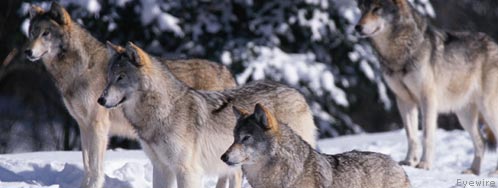The latest documentary that we viewed in class about the importance of predators opened up a lot of doors in my understanding of environmental science. In all honesty, the topic that this documentary brought up was perhaps the most interesting that I have ever covered or studied. It is fascinating to me how one organism can cause so much change to every level possible.
I think the best example of the far reaching effects by removing a predator from an ecosystem was best illustrated by the wolf in Yellowstone National Park. The most obvious and direct effects would be the increase of the population in the wolf’s prey: elk, deer, and other herbivores. With no keystone predator to monitor the population a large increase would become apparant. However, what about the far reaching effects. Scientists in the movie noticed the destruction and slow disappearence of aspens and willow plants surrounding rivers. After researching the aspens, they discovered that they stopped growing around 70 years ago, the same time that the last wolf disappeared in Yellowstone. This was no ordinary coincidence. Without a predator to eat the animals which used aspens for food, the aspens had no buffer and could no longer germinate effectively which is why there was a disappearence of these plants. This hypothesis gained more credibility when wolves were released back into Yellowstone in 1995. Upon their return, willow plants which had once been scarce were found and were thriving. Even more intriguing was the fact that in the film, these willow plants had been found right beside a wolf kill.
Based on these observations, I believe that the hypothesis was proved. Wolves had a large effect not only on their immediate trophic levels and prey, but on secondary and terciary trophic levels and species not even remotely associated with the wolf. Wolves, present an interesting dynamic in the predator dilemma as it gives credence to the belief that predators are a natural and necessary part of the world. 
Obviously, many will take major offense to this idea of reintroducing predators back into the wild. In 1995, the reintroduction of wolves into Yellowstone met great public scrutiny and resistance. This resistance is in no way unjustified. Despite all the services the keystone predators provide, they can also destroy an integral part of our current life. Ranchers still must deal with wolves killing their livestock and we must ask ourselves could we deal with similar situations? I believe not which is why it remains so essential for us to preserve those areas where these species can live as intented. Originally I didn’t totally agree with conservation of our natural parks. However, after seeing these creatures and the fragility of many species I can’t help but believe that conservation should be a major concern for everyone. Right now I believe that protecting our last fronteirs such as Yellowstone and ANWR remain more important than our own domestic resources. Isuppose that I’ve been corrupted by my APES class. Congragulations Mr. McKinley! I may finally be starting to see the light.
Leave a comment